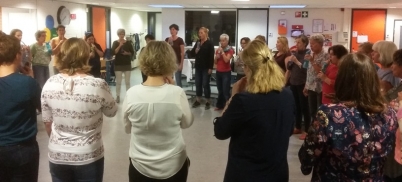Add a comment
From Dutch Pride to Route Sixteen
‹-- PreviousNext --›

I am just back from a full-on week of barbershop adventures in the Netherlands – an education weekend for Holland Harmony, framed by three coaching visits. There will be plenty to be blogged about as I process the experiences, so for today I am combining reports of my first two days’ coaching, with Dutch Pride in IJsselstein and Route Sixteen in Dordrecht.
Coaching sessions always cover far more musical details and technical achievements than you could possibly write about in a blog post, and I sometimes come out wondering what should be the focus of a coaching report. On Wednesday night, though, my brain woke me up in the middle of the night to inform me that I should write about a conversation we had about pitch retention after a key change. I have learned that I need to accept my brain’s suggestions if I hope to get any more sleep, so here goes.
Many a cappella ensembles will have had the experience of singing a song that includes a semi-tone key lift towards the end, but then find themselves finishing back in the key they started in before the lift. With Dutch Pride, we explored a variety of approaches to staying in the new key once you’re there.
First, we sang the very end in the right key, since if you have been in the habit of dropping, you probably don’t know what that feels like. We then went back and made sure the moment of the key change itself was really working for them – properly prepared, and achieving the expressive purpose it was there for. If you don’t get your knickers properly pulled up first thing, after all, you’re going to be in trouble for the rest of the day.
We then did an exercise to increase people’s awareness of the tonal centre. Every few bars, we would stop, and ask everyone to sing the key note, before checking the pitch. The point here is not just to establish where the tonal centre may be slipping, but to strengthen everyone’s internal sense of key. If you just sing note-to-note without ever really thinking about the wider tonal framework, it’s much more likely that your tonal centre will wander (it’s like transferred error in maths). If you have a clear internal reference point of the key, it is much easier to connect with it, and not be blown off course by momentary variations in the flow of the music.
During this exercise, we had a question about why we were doing this (which I hope to have answered again in the paragraph above), and this discussion made me articulate why it matters that we stay in the new key rather than dropping back.
Think back to the expressive effect of a key lift – as it raises the pitch, it raises the game. It escalates the message of the song, makes it more urgent. If you then gradually leak pitch thereafter, you undermine that moment of emphasis. It’s the musical equivalent of saying, ‘This is really important!....nah, don’t worry, didn’t really mean it…’ It’s like getting your knickers properly pulled up, and then letting your tights gradually sag until they are all wrinkly round your ankles. Pitch integrity, that is, is part of believability.
Believability was also on the agenda with Route Sixteen the following night. Our starting point was continuity of expression across phrase boundaries – how the music needs to stay in your face even when you’re not singing. This is about breath points (inhaling the thought of what you are going to sing next), but it’s also about the wider issue of moving beyond singing your part to performing the whole musical texture.
We moved onto exploring this wider issue further through tracing the construction of the song. It is a reasonably good generalisation about a cappella styles that the fewer parts are singing the words, the more intimate the mode of expression; conversely, when everyone is singing the words at the same time, the expression is more overt.
So, if you work through the song with people only singing out loud when they have words, you get a very clear picture of how the arranger has sculpted the emotional shape of the song. You can then draw immediate conclusions about where to make the delivery more gentle and personal, singing within the room, and where to become more declamatory, singing to the world.
One of the arrangements we worked on was unusual in barbershop terms for having a considerable number of chords where the basses were on either the 3rd or the 7th. It was a good opportunity to experience how these need singing – the 1st inversions needing poise, the 3rd inversions feeling like a chord on roller-skates. Once again, the implications were important for everyone: for the basses to adjust from their regular foundational role into something more subtle and nuanced, and for everyone else to respond to the expressive shape that results.
All these areas of attention have a reward in the way they enhance the audience experience. It was cheering that one of the comments at the end of the evening was that they also make the singer’s job easier. When you are thinking about the content of the song, rather than the act of singing, you become freer and more relaxed.
I can’t finish this report without telling you that, if you ever find yourself in Dordrecht on a sunny afternoon with time to wander, you can spend a very happy few hours pottering round the old havens in the historic district. It is full of architectural interest and totally delightful.












